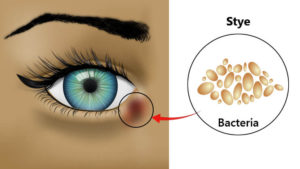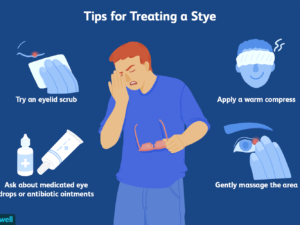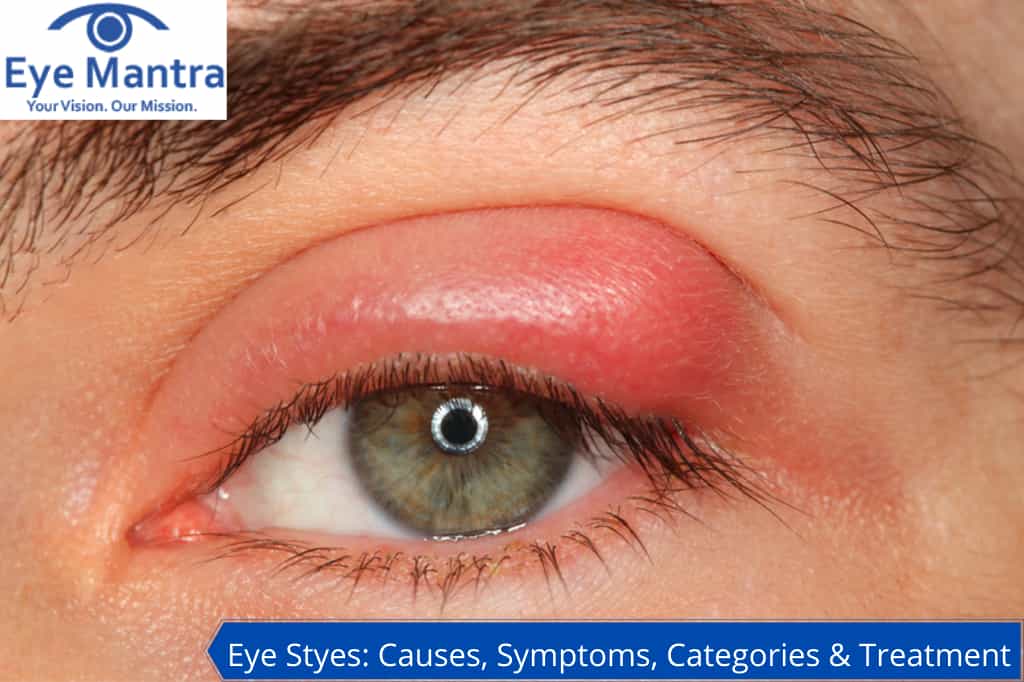Contents
What Is Eye Stye?
A stye is an inflammation of the eyelid caused by a small collection of pus. It is also known as a Sty or Hordeolum. It is a localized infection of the eyelid that causes a tender, red bump on the edge of the lid.
Most often, the infection is caused by Staphylococcus bacteria. It can happen at the base of the eyelash (external hordeolum) or in one of the small oil glands within the eyelid (internal hordeolum). The lump is red and painful and looks like a boil or pimple. Though most Eye Styes develop on the outside of the eyelid, in the anatomy of the eye, some may appear on the inside. Although common and extremely uncomfortable, styes are not generally a cause for concern.
There are seven things you should know about Eye Styes:
- The first signs are pain, swelling, redness, and tenderness.
- Styes don’t cause any vision problems.
- Styes are caused by Staphylococcal bacteria.
- They are infectious.
- Most styes heal on their own.
- Do not attempt to “pop” a Stye.
- Other eye problems may accompany styes.
- If a Stye continues for more than 1 week or is affecting vision, you must consult with the best ophthalmologist.
- Styes generally only affect one eye at a time.
- Eye Styes can be external or internal.
- Home remedies for styes include a warm compress and pain medication available over the counter.
In most cases, styes get better within 1 week without requiring any medical intervention. External Styes, or those outside the eyelid, may turn yellow and have pus. Internal Eye Styes that occur inside the eyelid tend to cause discomfort and are more painful.
Additionally, after a lot of thorough research and advice from a top ophthalmologist, our team of the leading eye hospital in Ghaziabad has shared their insights and authentic information through this blog.
Causes of Eye Styes
Usually, the lump of the Eye Stye is a combination of a clogged oil gland and bacteria. Our body has billions of friendly bacteria that live right along with us. Most of the time they cause no trouble. But sometimes, the bacteria may overproduce and create a pimple, due to some situations.

The risk of developing Stye increases under the following conditions:
- using cosmetics after their expiry dates,
- not removing eye makeup before going to sleep,
- not disinfecting contact lenses before wearing them,
- handling contact lenses without first washing hands thoroughly,
- poor nutrition,
- sleep deprivation,
- adolescents tend to have Eye Styes more frequently, but people of any age can develop them.
If someone nearby has an Eye Stye, those near him/her should not share face towels, etc. to minimize cross-infection.
Sometimes a Stye occurs as a complication of Blepharitis, an inflammation of the eyelids. Blepharitis is generally caused by a bacterial infection, but, sometimes can be a complication of Rosacea. An inflammatory skin condition that essentially affects the skin of the face.
Symptoms of Eye Styes
The patient will have a painfully small red lump on the eyelid, which can make the eye produce tears and become red. Sometimes it can look like a pimple.
Eye Styes very rarely affect both eyes at the same time. A person will generally have a sty in one eye. However, very rarely, there may be more than one Stye in the same eye or one in each eye.
Symptoms of Eye Styes can include:
- a lump on the eyelid,
- swelling of the eyelid,
- pain,
- redness,
- tenderness of the eyes,
- crusting of the edges of the eyelids,
- burning sensation,
- the droopiness of the eyelid,
- itching in the eye,
- Blurred vision,
- discharge of mucus from the eye,
- sensitivity towards light,
- tearing,
- discomfort in blinking,
- The constant feeling that there is some particle in the eye.
Remember, if a stye persists beyond one week, or if there are additional concerns such as vision impairment, excessive pain, bleeding, or if the swelling extends to other facial areas, immediate medical attention is recommended as these could indicate more serious complications.
Types of Eye Styes
Generally, there are two types of Stye:
External Hordeolum
External Eye styes develop along the outer edge of the eyelid. They can become yellow, filled with pus, and may get painful on touch. They can be caused by an infection in the following:
- Eyelash follicle: The tiny holes in the skin out of which the eyelashes grow.
- Sebaceous (Zeis) gland: This gland is attached to the follicles of the eyelashes. It produces Sebum. Sebum helps lubricate the eyelashes and prevents them from drying out.
- Apocrine (Moll) gland: This Apocrine gland also helps prevent eyelashes from drying out. It is a sweat gland that drains into the eyelash follicle.
Internal Hordeolum
The lump or the swelling develops inside the eyelid. Generally, an internal hordeolum is more uncomfortable and painful than an exterior one. They are also referred to as internal Stye. Most commonly, these are caused by an infection in the Meibomian gland. The purpose of these glands is to produce a secretion that makes up part of the film that covers the eye.
Patients may experience a burning sensation in the eye, crusting of the eyelid edges, droopiness of the eyelids, itchiness on the eyeball, sensitivity to light, tearing, a feeling that some particle is stuck to the eye, and distress during blinking.
Treatment of Eye Styes
A warm compress can be an effective way to get rid of an eye stye. Most Eye Styes go away on their own without the need for any treatment. When they rupture, symptoms start to improve rapidly.
But DO NOT Try To Burst a Stye Yourself!

The compress held gently over the eye may help ease symptoms. It should not be too hot. Special care should be taken when preparing it for someone else, especially a child. The compress should be held over the eye for 5 to 10 minutes and repeated three or four times each day.
Not only does the compress ease the discomfort, but it may also boost the pus to drain away. Once the lump and the pus drain away, symptoms improve rapidly.
Pain relievers may be helpful if there is pain. Those available for purchase over the counter or online, such as ibuprofen or acetaminophen, are effective enough.
- Use a warm compress,
- Or you may use a warm tea bag,
- Clean the eyelid with mild soap and water,
- Avoid wearing makeup and contact lenses,
- Use antibiotic ointments,
- Take mild, over-the-counter painkillers,
- Gently massage the area to promote drainage.
When an external sty is extremely painful and has existed for a longer period, an eye professional may remove the eyelash nearest to it, and drain the pus away by piercing it with a thin needle. This procedure should be carried out only by a professional.
If things still do not improve, Further eye examination may be required. It is advised not to apply eye makeup, lotions, or wear contact lenses until the stye has completely resolved.
Complications Related To Eye Styes
Though extremely rare, some complications may occur at times. These may be:
Meibomian Cyst
It is a cyst of the small glands located in the eyelid. The glands release a fluid, called Sebum, on the edge of the eyelid. This acts as a lubricant for the eyelid. A persistent Stye on the inside of the eyelid can ultimately become a Meibomian Cyst or Chalazion. Especially if the gland has some obstruction. The Meibomian cyst is easily and effectively treatable.
Pre-septal or Periorbital Cellulitis
This may develop when the infection spreads to the tissue around the eye. The layers of skin around the eye become inflamed, making the eyelids go red and swollen. The treatment for this condition is antibiotics.
Although these complications may occur, however, as mentioned earlier, most Eye Styes will clear without requiring medical intervention.
Conclusion
In conclusion, if you’re experiencing a stye that is internal, enlarging, increasingly painful, or doesn’t improve after a few days of home treatment, it’s crucial to consult an eye doctor immediately. This is especially important if the stye is affecting your vision. Additionally, if you find that styes are a recurring problem for you, it’s important to see a doctor, as this could be indicative of underlying issues like conjunctivitis, blepharitis, or cellulitis.
Remember, when it comes to eye diseases, early intervention is key. Don’t wait for symptoms to worsen. Book your free appointment today at the Best Eye Hospital in India. Call us on 9711116605 and take the first step towards better eye health. We offer a range of services including Cataract Surgery, Retina Surgery, Specs Removal, and more.
Related Articles:
Eye Infection: Common Causes, Symptoms and Treatment in Delhi



